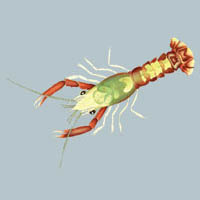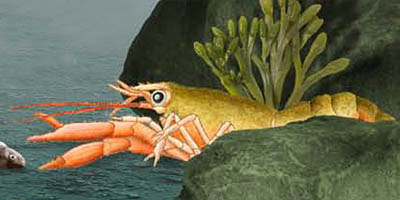A Lobster’s life on the bottom
1. An adult lobster can lay up to 100,000 eggs, depending on the size of the female. The female carries her fertilized eggs externally under her tail, attached to her swimmerets, for a period of 9 to 12 months. At this point, her eggs are the size of a grain of rice, dark green in color, and have an irregular shape. In Canadian waters, eggs are hatched between June and September, depending on water temperature.

Lobster eggs
2. After hatching, prelarvae are attached to the female. They molt shortly thereafter, and the stage one larvae are released and swim into the water column, to within a few centimetres of the surface; and this is where stage one of the planktonic larval phase begins. The larvae are somewhat protected from predators because they are transparent in color and about the size of a pea.

Stage one larva
3. In stage two and three of the planktonic larval phase, the lobster is about the size of a thumbnail. At stage three, larvae have a fully developed tail fan. Since the larvae are not particularly capable swimmers, much of their movement is controlled by wind and water currents. All stages of the lobster grow by molting; a process in which the old, hard shell is cast off and completely replaced with a new one.

Stage two and three larvae
4. In the postlarval stage, the lobster settles to the bottom of the ocean and finds shelter. Young lobsters prefer an inshore habitat of rocks, reefs or grass beds, remaining hidden there for the first years of life. At this stage, the lobster looks like a smaller version of an adult lobster.

Young lobster
5. In the early bottom phase, lobsters are mostly shelter restricted. Although they have developed the ability to move their tail effectively, their overall movement is limited. As they grow larger they begin to move outside their burrows looking for food.

Early bottom phase lobster
6. Lobsters reach adulthood within five to seven years, depending on water temperature. They spend most of their time alone in their shelters. Adult lobsters are most active after sunset, when they leave their shelter in search of food.
The male and female lobsters form a bond before and during mating process. The female first molts in the shelter of the male, mates with him, and stays with him for a few days. She later moves on her own, gorging herself on food while her new shell hardens. The eggs typically hatch approximately two years after molting/mating.

Adult lobster
© Her Majesty the Queen in Right of Canada, 2011
Cat. No.: Fs23-569/2011E
ISBN: 978-1-100-18153-0
- Date modified: